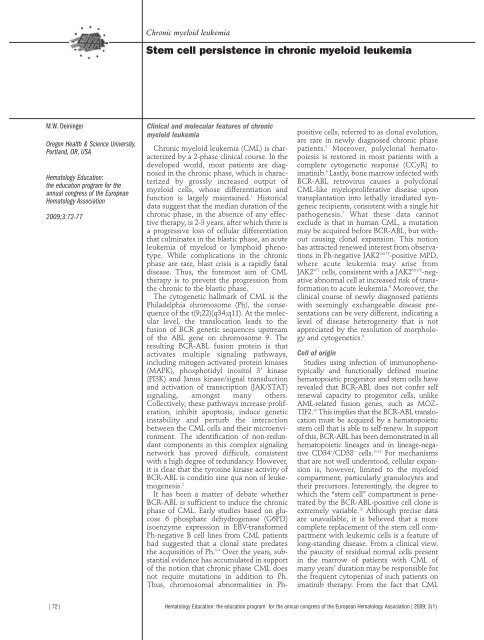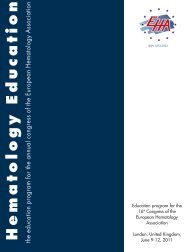hematology education - European Hematology Association
hematology education - European Hematology Association
hematology education - European Hematology Association
Create successful ePaper yourself
Turn your PDF publications into a flip-book with our unique Google optimized e-Paper software.
M.W. Deininger<br />
Oregon Health & Science University,<br />
Portland, OR, USA<br />
<strong>Hematology</strong> Education:<br />
the <strong>education</strong> program for the<br />
annual congress of the <strong>European</strong><br />
<strong>Hematology</strong> <strong>Association</strong><br />
2009;3:72-77<br />
Chronic myeloid leukemia<br />
Stem cell persistence in chronic myeloid leukemia<br />
Clinical and molecular features of chronic<br />
myeloid leukemia<br />
Chronic myeloid leukemia (CML) is characterized<br />
by a 2-phase clinical course. In the<br />
developed world, most patients are diagnosed<br />
in the chronic phase, which is characterized<br />
by grossly increased output of<br />
myeloid cells, whose differentiation and<br />
function is largely maintained. 1 Historical<br />
data suggest that the median duration of the<br />
chronic phase, in the absence of any effective<br />
therapy, is 2-3 years, after which there is<br />
a progressive loss of cellular differentiation<br />
that culminates in the blastic phase, an acute<br />
leukemia of myeloid or lymphoid phenotype.<br />
While complications in the chronic<br />
phase are rare, blast crisis is a rapidly fatal<br />
disease. Thus, the foremost aim of CML<br />
therapy is to prevent the progression from<br />
the chronic to the blastic phase.<br />
The cytogenetic hallmark of CML is the<br />
Philadelphia chromosome (Ph), the consequence<br />
of the t(9;22)(q34;q11). At the molecular<br />
level, the translocation leads to the<br />
fusion of BCR genetic sequences upstream<br />
of the ABL gene on chromosome 9. The<br />
resulting BCR-ABL fusion protein is that<br />
activates multiple signaling pathways,<br />
including mitogen activated protein kinases<br />
(MAPK), phosphotidyl inositol 3’ kinase<br />
(PI3K) and Janus kinase/signal transduction<br />
and activation of transcription (JAK/STAT)<br />
signaling, amongst many others.<br />
Collectively, these pathways increase proliferation,<br />
inhibit apoptosis, induce genetic<br />
instability and perturb the interaction<br />
between the CML cells and their microenvironment.<br />
The identification of non-redundant<br />
components in this complex signaling<br />
network has proved difficult, consistent<br />
with a high degree of redundancy. However,<br />
it is clear that the tyrosine kinase activity of<br />
BCR-ABL is conditio sine qua non of leukemogenesis.<br />
2<br />
It has been a matter of debate whether<br />
BCR-ABL is sufficient to induce the chronic<br />
phase of CML. Early studies based on glucose<br />
6 phosphate dehydrogenase (G6PD)<br />
isoenzyme expression in EBV-transformed<br />
Ph-negative B cell lines from CML patients<br />
had suggested that a clonal state predates<br />
the acquisition of Ph. 3-4 Over the years, substantial<br />
evidence has accumulated in support<br />
of the notion that chronic phase CML does<br />
not require mutations in addition to Ph.<br />
Thus, chromosomal abnormalities in Ph-<br />
positive cells, referred to as clonal evolution,<br />
are rare in newly diagnosed chronic phase<br />
patients. 5 Moreover, polyclonal hematopoiesis<br />
is restored in most patients with a<br />
complete cytogenetic response (CCyR) to<br />
imatinib. 6 Lastly, bone marrow infected with<br />
BCR-ABL retrovirus causes a polyclonal<br />
CML-like myeloproliferative disease upon<br />
transplantation into lethally irradiated syngeneic<br />
recipients, consistent with a single hit<br />
pathogenesis. 7 What these data cannot<br />
exclude is that in human CML, a mutation<br />
may be acquired before BCR-ABL, but without<br />
causing clonal expansion. This notion<br />
has attracted renewed interest from observations<br />
in Ph-negative JAK2 V617F -positive MPD,<br />
where acute leukemia may arise from<br />
JAK2 WT cells, consistent with a JAK2 V617F -negative<br />
abnormal cell at increased risk of transformation<br />
to acute leukemia. 8 Moreover, the<br />
clinical course of newly diagnosed patients<br />
with seemingly exchangeable disease presentations<br />
can be very different, indicating a<br />
level of disease heterogeneity that is not<br />
appreciated by the resolution of morphology<br />
and cytogenetics. 9<br />
Cell of origin<br />
Studies using infection of immunophenotypically<br />
and functionally defined murine<br />
hematopoietic progenitor and stem cells have<br />
revealed that BCR-ABL does not confer self<br />
renewal capacity to progenitor cells, unlike<br />
AML-related fusion genes, such as MOZ-<br />
TIF2. 10 This implies that the BCR-ABL translocation<br />
must be acquired by a hematopoietic<br />
stem cell that is able to self-renew. In support<br />
of this, BCR-ABL has been demonstrated in all<br />
hematopoietic lineages and in lineage-negative<br />
CD34 + /CD38 – cells. 11-12 For mechanisms<br />
that are not well understood, cellular expansion<br />
is, however, limited to the myeloid<br />
compartment, particularly granulocytes and<br />
their precursors. Interestingly, the degree to<br />
which the “stem cell” compartment is penetrated<br />
by the BCR-ABL-positive cell clone is<br />
extremely variable. 12 Although precise data<br />
are unavailable, it is believed that a more<br />
complete replacement of the stem cell compartment<br />
with leukemic cells is a feature of<br />
long-standing disease. From a clinical view,<br />
the paucity of residual normal cells present<br />
in the marrow of patients with CML of<br />
many years’ duration may be responsible for<br />
the frequent cytopenias of such patients on<br />
imatinib therapy. From the fact that CML<br />
| 72 | <strong>Hematology</strong> Education: the <strong>education</strong> program for the annual congress of the <strong>European</strong> <strong>Hematology</strong> <strong>Association</strong> | 2009; 3(1)












